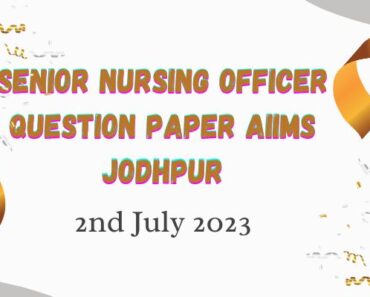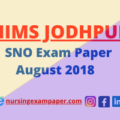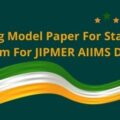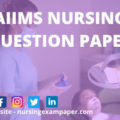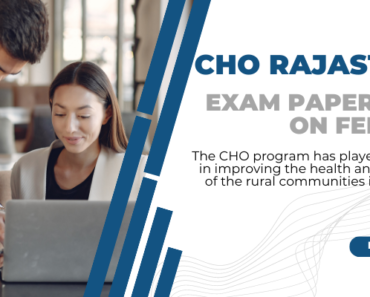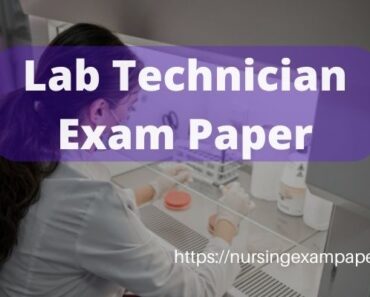We are glad to inform you that the Senior Nursing Officer Paper Questions paper AIIMS Jodhpur 2023 is now available for your reading. Which can play a vital role in your preparation for the upcoming Senior Nursing Officer Promotion Exam. It is a valuable resource to give you an understanding of the exam format, and content.
Reading previous exam papers gives you many benefits which contribute significantly to ensuring your success. Here are some of the advantages of familiarizing yourself with old exam papers:
- Introduction to Pattern: The previous SNO exam papers provide insight into the structure and format of the Senior Nursing Officer exam.
- Content Comprehension: Reviewing previous exam papers helps you identify key topics and concepts that are frequently tested.
- Exam Technique Enhancement: You can familiarize yourself with the type of questions asked, their difficulty level, and expected answer formats.
- Self-Assessment & Practice: Solving previous senior nursing officer exam papers lets you assess your preparation level.
This allows you to identify your strengths and weaknesses, allowing you to focus on areas that need further improvement. Additionally, practicing with previous papers helps boost confidence, reduces anxiety, and enhances overall performance on the day of the exam.
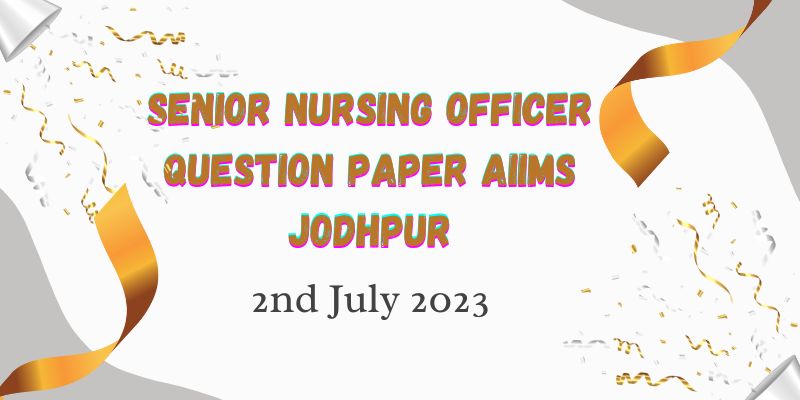
We strongly encourage you to make the most of this valuable resource by thoroughly reviewing the exam paper and incorporating it into your study plan. Best of luck with your preparations, and we look forward to seeing you excel in the Senior Nursing Officer Exam Paper.
Q. 1. A 54-year-old man presented in the emergency department with polyphagia and polydipsia. He also complained of headaches, malaise, and some visual changes. The assessment showed signs of dehydration and some additional symptoms. The nurse reported to the physician that the patient may have diabetic ketoacidosis. Which of the following additional symptoms might the nurse have noted?
1. Decreased respirations and increased urine output
2. Biot respirations and severe abdominal pain
3. Kussmaul respirations and fruity odor on the breath ✅
4. Cheyne-stokes respirations and foul-smelling urine
Q. 2. When ventilation exceeds perfusion, it leads to which of the following?
1. Dead space ✅
2. Pneumothorax
3. Silent unit
4. Shunt
Join Our Test Series
Q. 3 A normal man marries a woman with color blindness. Their children would be:
1. color blind sons and carrier daughters ✅
2. color blind daughters and carrier sons
3. normal daughters and normal sons
4. normal sons and carrier daughters
Q. 4 A nurse is going to administer ear drops to a 30-year-old patient suffering from otitis media. The most appropriate method to administer the ear drops to this patient is by:
1. pulling the pinna down and back
2. separating the palpebral fissures with a clean gauze pad
3. pulling the tragus up and back
4. pulling the pinna up and back ✅
Q. 5 Infant Mortality Rate (IMR) is the ratio of deaths under 1 year of age to:
1. a rate per 10,000 live births
2. a rate per 1000 live births ✅
3. a rate per 10 live births
4. a rate per 100 live births
Q. 6 A problem-based learning is student student-centered learning strategy in which students collaboratively solve problems and this reflects on their experience. One important component is:
1. careful inspection of methods
2. presentation of real-world situations or problems from ordinary life ✅
3. focus of the educational program
4. flexible approaches to learning
Q. 7 All of the following are local manifestations of inflammation EXCEPT:
1. pain
2. redness
3. increased WBC count ✅
4. warmth
Q. 8 A patient has been received in the emergency department of a hospital with a history of head injury. The nurse in the ER makes a quick neurological assessment of the patient using the Glasgow Coma Scale. Her assessment findings are shown in the given table. What will you interpret based on the given table? (Senior Nursing Officer Paper Aiims Jodhpur)
| Name: ABCD | Age: 28 Y | CR No: 123456 |
|---|---|---|
| BEHAVIOUR | RESPONSE | SCORE |
| Eye-opening response | Opens eyes to the pain | 2 |
| Verbal response | Speaks inappropriate words | 3 |
| Motor response | Abnormal flexion is observed | 3 |
| Total GCS score | 8 |
1. Mild brain injury
2. Moderate brain injury
3. No neurological deficit
4. Severe brain injury ✅
Q. 9 Following a road accident, a patient was admitted to the neurosurgery ICU due to a head injury. During the assessment, the patient opens his eyes to painful stimuli but not to verbal stimuli. He answers questions by making incomprehensible sounds and localizes the site of the painful stimulus. His GCS score will be:
1. 6
2. 7
3. 8
4. 9 ✅
Q. 10 The misunderstanding or misinterpretation of the meaning which restricts effective communication is known as:
1. emotional barrier
2. cultural barrier
3. semantic barrier ✅
4. physical barrier
Q. 11 A client is admitted to the ward at 4 pm. She is posted for haemorrhoidectomy the next day morning. The nurse is expected to record the assessment of her vital signs. Before checking the blood pressure, the most important principle the nurse has to follow is:
1. position the client
2. explain the procedure to the client ✅
3. wash hands
4. prepare the equipment and supplies
Q. 12 Second component (other than NST) in the Modified Biophysical Profile is:
1. Foetal movements
2. Foetal tone
3. Foetal breathing movements
4. Amniotic fluid Index ✅
Q. 13 According to the Bio-medical Waste Management of India, Category 1 of waste, including human anatomical waste, should be disposed of by:
1. local autoclaving
2. disposal in municipal landfill
3. incineration ✅
4. disinfection by chemical treatment
Q. 14 CDC recommends children get two doses of MMR vaccine, starting with the first dose at 12 through 15 months of age, and the second dose at:
1. 2-3years of age
2. 6-8 years of age
3. 4-6 years of age ✅
4. 10-12 years of age
Q. 15 A woman visited the pediatrics OPD with her 2-year-old toddler with complaints of sudden stoppage of breath in the child initiated by a provocative event. All the following are true about breath-holding spells EXCEPT:
1. they are involuntary
2. bradycardia may occur
3. they occur during the inspiration ✅
4. cyanosis may/ may not occur
Q. 16 The optimal target for patients with diabetes mellitus is maintaining glycated hemoglobin (HbA1c) at:
1. above 6.5%
2. below 9%
3. above 9%
4. below 6.5% ✅
Q. 17 _______ is an example of secondary prevention.
1. Treatment of the disease and rehabilitation
2. Screening and case finding ✅
3. Proper disposal of garbage
4. Encouraging physical exercise
Q. 18 The T wave in ECG represents:
1. total time for ventricular depolarization
2. ventricular repolarisation ✅
3. repolarisation of Purkinje fibres
4. time needed for sinus node stimulation
Q. 19 At the Central level, the Union Ministry of Health and Welfare is headed by a Cabinet Minister, a Minister of State, and a Deputy Health Minister. These are political appointments and have a dual role to serve political as well as administrative responsibilities for health. One of the functions in the Union List is:
1. prevention of extension of communicable diseases from one unit to another
2. to organize family welfare programs through family welfare centers
3. regulation and development of medical, nursing, and other allied health professions ✅
4. International health relations and quarantine
Q. 20 The ‘Food Guide Pyramid’ is a nutritional educational guide that emphasizes the importance of foods from different food groups. Which of the given statements is/are correct?

1. Each of the food groups (shown in the picture) provides some of the nutrients required.
2. Each of the food groups] provides all the nutrients required.
3. Foods in one group cannot replace those in another.
4. Food groups towards the top of the pyramid are increasingly more important.
1. Only 2
2. Only 1 and 4
3. Only 2 and 4
4. Only 1 and 3 ✅
Senior Nursing Officer Exam Questions
Q. 21 The main features of the rural community are that the rural community is closely associated with:
1. remote from nature
2. work in a closed environment
3. work in different occupations and contact is less between members
4. direct effect of natural elements like rains, drought, and heat, on their lives ✅
Q. 22 The first drug of choice to treat an anaphylactic reaction is:
1. bronchodilator
2. antihistamines
3. corticosteroids
4. epinephrine ✅
Q. 23 During discharge teaching, a patient with depression, the psychiatric nurse informed him to avoid foods containing tyramine – such as cheese, milk, wine, preserved meats, and avocados – to prevent a hypertensive crisis. Which class of antidepressant drugs are prescribed to the patient?
1. Monoamine oxidase inhibitors ✅
2. Selective serotonin reuptake inhibitors
3. Tricyclic antidepressants
4. Selective norepinephrine reuptake inhibitors
Q. 24 Water hammer pulse is seen in:
1. aortic stenosis
2. mitral stenosis
3. aortic regurgitation ✅
4. left ventricular failure
Q. 25 Beta-thalassemia is an autosomal recessive disorder. It is characterized by reduced hemoglobin levels in the body and is also known as Senior Nursing Officer Paper Aiims Jodhpur
1. sickle cell anaemia
2. aplastic anaemia
3. Cooley’s anemia ✅
4. haemolytic anaemia
Q.26 A physician has prescribed Tab Atenolol 25 mg for a patient. On assessment, the nurse finds that the patient’s systolic blood pressure is 90 mmHg. The appropriate nursing action would be:
1. administer the drug and continue monitoring the blood pressure
2. withhold the drug and notify the prescriber ✅
3. monitor serum potassium levels
4. advice the patient to increase sodium intake
Q.27 Doctors and nurses, who are in direct contact with patients and their relatives, have opportunities for individual health education. What is the biggest advantage of individual health education?
1. We can discuss, argue, and persuade the individual to change his behavior. ✅
2. It can be costly and time-consuming.
3. It depends upon the personality and reputation of the speaker.
4. It is very useful in reaching a large number of people
Q.28 A 30-year-old patient was brought to the emergency department. On examination, the triage nurse noticed that his respiratory rate was 36/ minute, and he had a non-productive cough. History also revealed that he recently had a cold. After lung auscultation and analysis of examination findings, she suspected the probability of asthma. Which of the following lung auscultation findings suggested that he may have bronchial asthma?
1. Pericardial friction rub
2. Inspiratory and expiratory wheezes ✅
3. Low-pitched murmurs
4. Pleural friction rub
Q.29 A nurse working in a ward notices that blood has spilled on the floor during blood collection. The spill covers an area of more than 20 cm. The nurse asked the housekeeping staff to clean the spill on the floor. What would the recommended disinfectant used for handling this spill be?
1. 1: 2 dilution of 2% bleach solution
2. 1: 10 dilution of 5% of sodium hypochlorite ✅
3. 1: 5 dilution of 5% bleach solution
4. 1: 100 dilution of 5% sodium hypochlorite
Q.30 The ideal time when the nurse asks the patient to bear down during the second stage of labour is:
1. When the fetal head starts to distend the perineum ✅
2. In between the contractions
3. When the patient feels strong
4. When the cervix is fully dilated
Q.31 Which of the following tarsal bones is most commonly fractured?
1. Calcaneus ✅
2. Talus
3. Navicular bone
4. Cuboid bone
Q.32 Which type of coping strategy is most effective during a stressful circumstance that cannot be changed?
1. Coping flexibility
2. Problem-focused coping
3. Emotion-focused coping ✅
4. Avoidance
Q.33 The leakage of blood backward through the mitral valve each time the left ventricle of the heart contracts, is known as:
1. mitral stenosis
2. mitral regurgitation ✅
3. mitral systole
4. mitral prolapse
Q.34 The nurse manager compares the actual results of the budget with the projected results of the budget. What budgeting process is this?
1. Variable budgeting
2. Revenue sharing
3. Incremental budgeting
4. Controlling
Q. 35 Identify the larva of the mosquito shown in the given picture.

1. Mansonia
2. Culex
3. Aedes
4. Anopheles ✅
Q.36 A group of subcortical nuclei within the brain called basal ganglia helps a person perform which of the following important functions? (Senior Nursing Officer Paper)
1. Unconditional learning
2. Involuntary motor activity
3. Learning impairment
4. Emotional behaviours ✅
Q.37 What is the function of mRNA?
1. Escorts amino acid to ribosome
2. Carries message for protein synthesis ✅
3. Helps form the ribosomes
4. Bonds with a new strand
Q.38 A nurse posted in the pediatric ward was doing a dehydration assessment for a child admitted with complaints of diarrhea. The nurse noted that the child was unconscious, and he had sunken eyes and a skin pinch going back very slowly. Also, the child was not able to drink fluids. Based on these observations, what should the nurse categorize this dehydration as?
1. Moderate dehydration
2. Mild dehydration
3. No dehydration
4. Severe dehydration ✅
Q.39 If the calculated Chi-square value in hypothesis testing is greater than the critical Chi value, then:
1. do not reject the null hypothesis
2. estimate again
3. do nothing
4. reject null hypothesis ✅
Q.40 Patient X came to the emergency department with a history of road traffic accidents. The triage nurse assessed the patient and shifted him to the Red area. During the assessment, she found that the patient had fractured a segment sinking into the chest with inspiration and expanding of the chest wall with expiration, opposite the normal chest wall mechanics. Which of the following abnormalities would have been noted by the nurse and what would this abnormality indicate?
1. Flail chest; Rib fracture ✅
2. Barrel chest; Rib fracture
3. Pectus excavatum; Chest trauma
4. Pectus carinatum; Chest trauma
SNO Question Paper 2023
Q.41 While recording the weight of a 2-year-old boy on the WHO growth chart, a nurse notes that the weight curve is below -2 SD. The nurse interprets this as:
1. severely underweight
2. under nutrition ✅
3. overweight for his age
4. normal weight for his age
Q.42 Which of the following statements is INCORRECT concerning the portal vein?
1. Portal blood comes from the gastrointestinal system.
2. Portal circulation constitutes 80% of the circulation to the liver.
3. Portal blood is rich in oxygen. ✅
4. Portal blood is rich in nutrients
Q.43 An example of inductive reasoning is:
1. using a standard nursing care plan to care for a specific patient
2. reasoning from a single diabetic patient to all diabetic patients ✅
3. using a computerized nursing care plan to care for insulin-dependent diabetic patients
4. reasoning from all chronically ill patients to a single chronically ill patient
Q.44 A nurse posted in the postnatal ward is going around assessing patients. The nurse should anticipate that postpartum women with _______ will need Rh(D) immune globulin (RhoGAM) before discharge.
1. an Rh-positive primigravida with an Rh-positive infant
2. an Rh-negative primigravida with an Rh-positive infant ✅
3. an Rh-negative primigravida with an Rh-negative infant
4. an Rh-positive primigravida with an Rh-negative infant
Q. 45 A suprapubic cystostomy with a male cat catheter has been ordered for a patient. which of the given catheters in the images would you keep in your tray?

1. 4
2. 1 ✅
3. 2
4. 3
Q.46 Which of the following is an important principle of delegation?
1. Responsibility is not transferred with a delegation
2. Delegation is the same as work allocation
3. When delegating, you must transfer authority ✅
4. No transfer of authority exists when delegating
Q.47 The primary fever in malaria corresponding to the development of the parasites in the red blood cells comprises all of the following EXCEPT: Senior Nursing Officer Paper Aiims Jodhpur
1. cold stage
2. hot stage
3. sweating stage
4. relapse stage ✅
Q.48 Down’s syndrome is a congenital chromosome abnormality and is also known as:
1. Trisomy 18
2. Trisomy 31
3. Trisomy 21 ✅
4. Trisomy 20
Q. 49 Identify the contraceptive device shown in the given picture.

1. Diaphragm
2. Female condom ✅
3. vaginal sponge
4. Male condom
Q. 50 The year 2023 has been declared as the international year of:
1. Nuts
2. Fruits
3. Millets ✅
4. Cereals
Q.51 A tumor of the Adrenal medulla (Pheochromocytoma) is associated with increased production of which hormone?
1. Androgen
2. Glucocorticoids
3. Epinephrine ✅
4. Mineralocorticoids
Q.52 The nurse is preparing for the physical examination of a newly admitted client. The assessment tray should contain all the following, EXCEPT:
1. sphygmomanometer
2. thermometer
3. stethoscope
4. fundo-scope ✅
Q.53 While doing bedside rounds, a nurse posted in the pediatric urology ward saw a 5-year-old child. On being asked about the child’s medical history, the child’s mother said that the child had recently had a streptococcal throat infection. She also reported periorbital and facial odema, decreased urine output, and haematuria. The child’s blood pressure was 156/98 mm of Hg and lab investigations showed increased blood urea nitrogen level and creatinine level and increased anti-streptolysin O titer. Based on these inputs, what may be the probable diagnosis of the child?
1. Haemolytic uremic syndrome
2. Polycystic kidney disease
3. Nephrotic syndrome
4. Glomerulonephritis ✅
Q.54 A leader can be effective in one circumstance and can be ineffective in another circumstance. This is a leader’s ability to adapt, which can be their most important tool in the workplace. This theory of leadership is known as: (Senior Nursing Officer Paper)
1. autocratic
2. strategic
3. democratic
4. contingency ✅
Q.55 Which of the following is a stage in the stages of change model?
1. Contemplation ✅
2. Study
3. Deliberation
4. Meditation
Q.56 A probability distribution that is symmetric about the mean, showing that the data near the mean are more frequent in occurrence than the data far from the mean, is known as:
1. binominal distribution
2. skewed distribution
3. normal distribution ✅
4. Poisson distribution
Q.57 Glomerulonephritis is a kidney disorder that affects the glomeruli. It is usually characterized by edema, hypertension, and:
1. polydipsia
2. haematuria ✅
3. WBC in urine
4. dysuria
Q.58 A patient presented to the pediatric OPD with fever, malaise, coryza, cough, and conjunctivitis. There were small red spots with a bluish-white center and a red base located on the buccal mucosa and nurses documented this finding. What are these spots called and what are the spots indicative of?
1. Brush field spots; measles
2. Bull neck spots; diphtheria
3. Koplik’s spots; diphtheria
4. Koplik’s spots; measles ✅
Q. 59 The lab report of a patient is detailed below:
| PH | 7.12 |
| HCO3- | 1mmol/L |
| PCO2 | 18mm Hg |
Which of the following is the primary acid-base disorder?
1. Respiratory Alkalosis
2. Respiratory Acidosis
3. Metabolic Alkalosis
4. Metabolic Acidosis ✅
Q.60 The nurse manager needs to buy six new hospital beds for the unit. What type of budget will be used for this expenditure?
1. Revenue budget
2. Salary budget
3. Operating budget
4. Capital budget ✅
Aiims senior nursing officer paper
Q.61 The leadership style adopted to make crucial decisions that need to be made on the spot, when dealing with inexperienced and new team members and there’s no time to wait for team members to gain familiarity with their role, is known as:
1. participatory
2. democratic
3. authoritative ✅
4. coaching
Q. 62 A nurse plans to teach a postpartum mother the prevention of breast engorgement. Which of the following measures would the nurse include in her teaching plan?
1. Use nipple shields while feeding the neonate
2. Decrease the intake of fluid during the first 24 to 48 hours
3. Massage the breast vigorously before feeding
4. Breastfeed the neonate at regular intervals ✅
Q. 63 You have collected a pus sample from a purulent lesion on the skin of a patient. You have sent the sample for gram staining. The microbiologist reports staphylogist reports staphylococci seen. which of the above shapes of bacteria must the microbiologist have seen?

- 1
- 4
- 3
- 2 ✅
Q.64 During a home visit by a community health nurse, a middle-aged woman reported to the nurse that she has had Weakness, fatigue, dyspnoea, and headache for the past three months. On physical examination, the nurse noted spoon-shaped fingernails and a heart rate of 120/minute. Based on these findings, the nurse documented that the woman may have ________.
1. Iron deficiency Anaemia ✅
2. Aplastic Anaemia
3. Folic acid deficiency Anaemia
4. Haemolytic Anaemia
Q. 65 A patient with COAD has to be put on oxygen using a face mask. Identify the type of mask shown in the picture below.

1. CPAP mask
2. Venturi mask ✅
3. Face mask with reservoir bag
4. Simple face mask
Q.66 A short-term goal for a patient with Alzheimer’s disease is:
1. regained sensory perception and cognitive function
2. improved functioning in the least restrictive environment ✅
3. improved problem-solving in activities of daily living
4. increased self-esteem and improved self-concept
Q.67 What is the best position for a patient in anaphylactic shock?
1. Lateral recumbent
2. Semi fowler’s
3. High Fowler’s
4. Supine with legs elevated ✅
Q.68 The kidneys are located ________ on the posterior abdominal region.
1. supra peritoneally
2. infra peritoneally
3. retroperitoneally ✅
4. in the peritoneal cavity
Q. 69 Identify the fontanel indicated by the arrow.

1. Temporal fontanel
2. Posterior fontanel
3. Anterior fontanel ✅
4. Occipital Fontanel
Q.70 In India, unsafe drinking water and lack of basic sanitation are the leading causes for:
1. asthma
2. heart disease and diabetes
3. diarrhoeal diseases and cholera ✅
4. respiratory problems
Q.71 A client has an infection spreading through droplets. The nurse is ready to check the client’s temperature. Which of the following should the nurse use to control the spread of infection?
1. Gown
2. Goggles
3. Gloves
4. Mask ✅
Q.72 Which of the following types of research involves at least some control by the researcher to implement the study treatment? Senior Nursing Officer Paper 2018
1. Descriptive
2. Experimental
3. Quasi-experimental ✅
4. Correlational
Q.73 A nurse posted in a Paediatrics cardiology unit noted that the assessment findings of an infant reveal a continuous machinery murmur on the auscultation of the heart and signs of heart failure. She identifies that the infant has which of the following congenital cardiac defects?
1. Ventricular septal defect
2. Atrial septal defect
3. Patent ductus arteriosus ✅
4. Aortic stenosis
Q.74 A terminally ill 70-year-old lady has fears of being alone and constantly wants someone near her. Which of the following actions by the nurse would be most appropriate to deal with her loneliness?
1. Place her near the window so that she can see nature
2. Explain to her that she has to keep her mind active and focused
3. Put on the Television in her room and ask her to watch some programs
4. Plan to spend more time with her holding her hands and listening to her ✅
Q.75 A client is admitted with acid attack burns on his face and eyes. The nurse understands that the client has a great risk for which of the following complications?
1. Long-term morbidity
2. Bacterial infections
3. Contracture
4. Development of glaucoma ✅
Q.76 A 2-year-old child is brought to the pediatric OPD with the complaint of failure to thrive. On assessment, the nurse observes that the child weighs less than 3SD, as per the WHO growth chart, and MUAC (Mid Upper Arm Circumference) is less than 11 cm. What would the nurse suspect of this child?
1. Moderate acute malnutrition
2. Acute malnutrition
3. Severe acute malnutrition ✅
4. Chronic malnutrition
Q.77 Hospital information systems (HISs) are introduced in a hospital to support tasks like patient care and administration of a hospital. The nurses are expected to have a cultural lag which can be overcome by which of the following?
1. The Organisation should leave the nurses to learn or not learn HIS.
2. The Organisation should invest in equipment and training the nurses. ✅
3. The Organisation should refine policies to force the nurses to adapt to the change.
4. The Organisation should recruit new nurses who are trained in HIS.
Q.78 A shortened PR interval, slurring (called a delta wave) of the initial QRS deflection, and prolonged QRS duration are characteristics of:
1. atrial tachycardia
2. myocardial ischemia
3. Wolff-Parkinson-White (WPW) syndrome ✅
4. left bundle branch block
Q.79 Children with Down’s syndrome have what is known as brachycephaly. This means that the shape of the back of the head is:
1. pointed
2. flattened ✅
3. rounded
4. pyramidal
Q.80 According to WHO, the most cost-effective way to stop the spread of TB in communities with a high incidence is by curing it. The best curative method for TB is known as DOTS. One of its components is:
1. health for All by 2000 AD
2. Standardised treatment regimen directly of eighteen months observed by a healthcare worker
3. patients will buy the drugs
4. case detection by sputum smear microscopy ✅
Images for Senior Nursing Officer Question Paper
Q.81 Acid-fast staining used in the above slide showing Mycobacterium-tuberculi is named:

1. Ziehl-Neelsen staining ✅
2. gram staining
3. Giemsa staining
4. Albert’s staining
Q.82 There are various techniques that are used to preserve foods and prevent foods from spoiling. Which of the following is the most common and best method?
1. Heating ✅
2. Freezing
3. Freeze drying
4. Fermentation
Q.83 Given below is an ECG of a patient with chest pain due to ischemic heart disease. The ECG shows:

1. ST depression ✅
2. T wave inversion
3. increased PR interval
4. increased QRS interval
Q.84 Regarding the placement of leads when recording ECG all of the following are correct, EXCEPT:
1. V3 – linear midpoint between V2 and V4
2. V1 – 4th intercostal space – right margin of sternum
3. V2 – 4th intercostal space – left margin of sternum
4. V4 – 7th intercostal space at the mid clavicular line ✅
Q.85 When an antigen is mixed with its corresponding antibody at a suitable pH and temperature, the antigen-antibody reaction causes clumping of particles together. This reaction is known as:
1. complement fixation
2. agglutination reaction ✅
3. immunofluorescence
4. precipitation reaction
Q.86 The part of the colon that absorbs the remaining water and other key nutrients from the indigestible material, solidifying it to form stool is: (SNO Paper Aiims Jodhpur)
1. transverse colon
2. ascending colon ✅
3. rectum
4. descending colon
Q.87 Suppose you were a nurse who was posted in the Covid-19 screening area where RT-PCR testing was conducted. Which transport media was used in the transport tube of Covid-19 swabs?
1. RAT
2. VVM
3. VTM ✅
4. PCR
Q.88 Benzimidazole used in the treatment of parasitic infections is:
1. None of the given option
2. a broad-spectrum anthelmintics ✅
3. a broad-spectrum antibiotic
4. an antifungal drug
Q.89 A patient was brought to the emergency ward with numbness and weakness on one side of his body, slurred speech, difficulty in walking, and dizziness. After taking a CT scan, the doctor diagnosed it as an embolic stroke. Which of the following conditions places the client at risk of a thromboembolic stroke? (Senior Nursing Officer Paper Aiims Jodhpur)
1. Multiple sclerosis
2. Atrial fibrillation ✅
3. Bradycardia
4. Guillain-Barré syndrome
Q.90 The main objective of the National Iodine Deficiency Disorders Control Programme in India is:
1. early detection of iodine deficiency
2. supply of Iodised salt in place of common salt ✅
3. Behaviour Change Communication
4. development of guidelines on control
Q.91 A nurse is headed to work with her friend on a bus. Suddenly, she notices blood coming from her friend’s nose. What is the first line of management that the nurse can use in this situation?
1. Pinch the nose and move forward ✅
2. Pinch the nose with sterile gauze
3. Do not touch the nose and immediately go to the hospital
4. Pinch the nose and move Backwards
Q.92 Epigenic factors play an important role in schizophrenia. In genetically vulnerable people, environmental factors may increase the risk and trigger schizophrenia. Which of the following statements is true?
1. Living in poverty does not increase the risk of schizophrenia.
2. Childhood trauma such as poverty or abuse can trigger schizophrenia. ✅
3. Social companionship increases the risk of schizophrenia.
4. People living in rural areas are more vulnerable
Q.93 A nurse is posted in the pediatric immunization clinic. She notices a child who is very active. He is climbing stairs in the playroom, walking forward, and turning pages in a book. Based on these observations, what may be the approximate age of the child?
1. 6-9 months
2. 8-10 months
3. 18-24 months ✅
4. 10-12 months
Q.94 Identify the instrument shown in the picture.

1. Otoscope
2. Sigmoidoscope
3. Arthroscope
4. Ophthalmoscope ✅
Q.95 The blood groups in individuals are different due to the specific:
1. antibodies on the surface of RBCs
2. antigens on the surface of WBCs
3. antigens on the surface of RBCs ✅
4. antibodies on the surface of WBCs
Q. 96 Identify the study design given in the picture.

1. Prospective cohort study
2. Retrospective cohort study
3. Nested case-control study
4. Case-control study ✅
Q.97 On physical examination of a patient’s chest, a nurse observed a ‘barrel chest’. A barrel chest is usually associated with: (Senior Nursing Officer Paper)
1. Marfan syndrome
2. emphysema ✅
3. rickets
4. kyphoscoliosis
Q.98 Low molecular weight heparin should be administered:
1. intramuscularly
2. intravenously
3. subcutaneously ✅
4. intradermally
Q.99 To use a t-test, the dependent variable must have:
1. ordinal or ratio data
2. nominal or interval data
3. ordinal or interval data
4. interval or ratio data ✅
Q. 100 While conducting the delivery of a woman, a midwife suddenly finds that the internal rotation of the shoulders is not occurring even after good uterine contractions. To release the anterior shoulder, she is performing which of the following manoeuvres in the given picture?

1. McRoberts manoeuvres ✅
2. Lovset’s manoeuvres
3. Rubin manoeuvres
4. Corkscrew manoeuvres
Also Read –
Download the Senior Nursing Officer Paper Aiims Jodhpur 2023 in pdf format
RRB Nursing Question Paper with Answers pdf
RRB Question Paper Previous Year
Railway staff nurse question paper 2019
